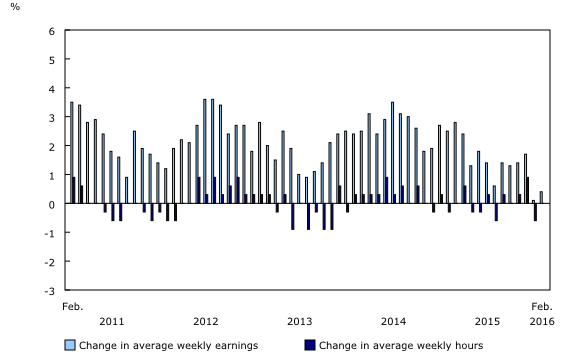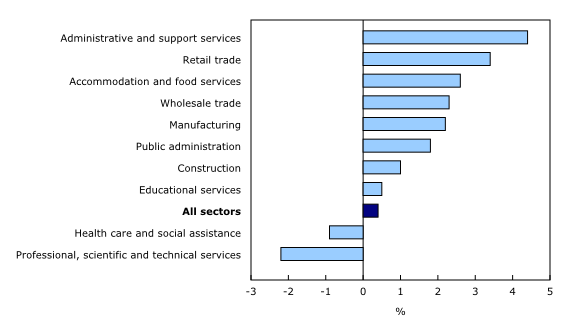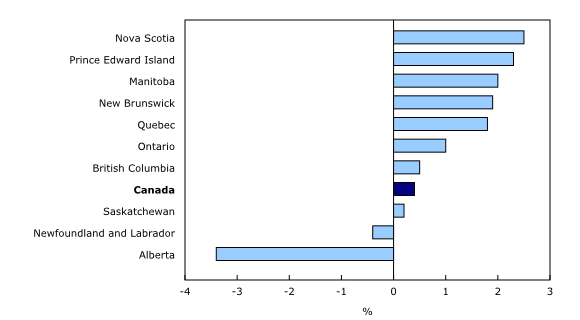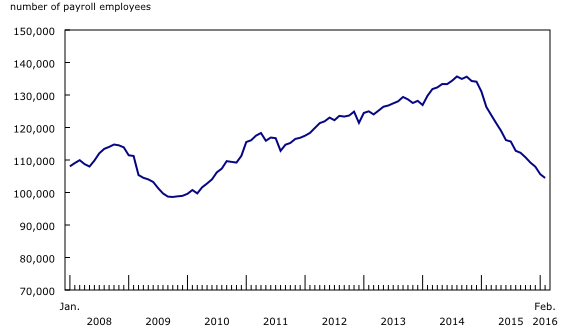Payroll employment, earnings and hours, February 2016
Archived Content
Information identified as archived is provided for reference, research or recordkeeping purposes. It is not subject to the Government of Canada Web Standards and has not been altered or updated since it was archived. Please "contact us" to request a format other than those available.
Released: 2016-04-28
$953.75
February 2016
0.4% 
(12-month change)
$1,012.09
February 2016
-0.4% 
(12-month change)
$808.83
February 2016
2.3% 
(12-month change)
$847.77
February 2016
2.5% 
(12-month change)
$867.82
February 2016
1.9% 
(12-month change)
$873.56
February 2016
1.8% 
(12-month change)
$965.60
February 2016
1.0% 
(12-month change)
$892.99
February 2016
2.0% 
(12-month change)
$993.09
February 2016
0.2% 
(12-month change)
$1,118.48
February 2016
-3.4% 
(12-month change)
$913.45
February 2016
0.5% 
(12-month change)
$1,049.52
February 2016
-0.5% 
(12-month change)
$1,438.57
February 2016
3.2% 
(12-month change)
$1,263.40
February 2016
2.7% 
(12-month change)
Average weekly earnings of non-farm payroll employees were $954 in February, little changed from the previous month (+0.3%) and from 12 months earlier (+0.4%). Earnings growth has levelled off since February 2015.
The change in weekly earnings reflects a number of factors, including wage growth, changes in the composition of employment by industry, occupation and level of job experience, as well as average hours worked per week.
Non-farm payroll employees worked an average of 32.9 hours per week in February, little changed from the previous month and unchanged compared with the same month a year earlier.
Average weekly earnings by sector
From February 2015 to February 2016, average weekly earnings increased in 6 of the 10 largest industrial sectors, led by administrative and support services. At the same time, earnings declined in professional, scientific and technical services as well as in health care and social assistance, and were little changed in construction and in educational services.
In administrative and support services, average weekly earnings rose 4.4% to $802, continuing an upward trend that began in September 2014. Employment services recorded the largest growth on a year-over-year basis, with most of the gains occurring in the spring and summer of 2015.
Compared with 12 months earlier, weekly earnings in retail trade increased 3.4% to $550. Part of this growth was due to the fact that earnings in this sector were at a low point in February 2015. The gains were spread across several subsectors, led by clothing and clothing accessories stores and general merchandise stores.
Average weekly earnings in accommodation and food services grew 2.6% to $378, mainly the result of gains in full-service restaurants and limited-service eating places.
In wholesale trade, earnings increased 2.3% to $1,221 in the 12 months to February. Growth was spread across most subsectors, with the largest increase in building material and supplies wholesalers.
Among manufacturing employees, weekly earnings were up 2.2% to $1,083 compared with February 2015. Earnings growth in the sector was widespread, with notable gains in the manufacturing of plastics and rubber products, machinery, and food.
On the other hand, average weekly earnings in professional, scientific and technical services declined 2.2% to $1,309. Earnings losses were mainly in architectural, engineering and related services; computer systems design and related services; and management, scientific and technical consulting services.
Average weekly earnings by province
Year over year, average weekly earnings of non-farm payroll employees increased in six provinces in February, with the strongest growth in Nova Scotia. At the same time, earnings declined in Alberta and were little changed in British Columbia, Saskatchewan and Newfoundland and Labrador.
Compared with February 2015, average weekly earnings in Nova Scotia were up 2.5% to $848. Earnings growth was widespread, led by construction, educational services and retail trade.
Average weekly earnings in Prince Edward Island rose 2.3% to $809. The largest gains were in manufacturing, retail trade, and administrative and support services.
In the 12 months to February, weekly earnings in Manitoba increased 2.0% to $893, with gains spread across the majority of sectors. The largest contributors were manufacturing, educational services, and finance and insurance.
In Quebec, earnings were up 1.8% to $874. Earnings increased in many sectors, with the largest growth in educational services, retail trade, construction and manufacturing. Most of the year-over-year earnings growth in Quebec was due to gains in early 2015.
Average weekly earnings in Ontario grew 1.0% to $966, led by gains in administrative and support services, wholesale trade, and manufacturing. At the same time, earnings declined notably in utilities, health care and social assistance, and professional, scientific and technical services, offsetting some of the growth observed in other sectors.
Earnings in Alberta fell 3.4% to $1,118 in the 12 months to February, continuing a trend of year-over-year declines that began in the summer of 2015. Employment losses in the high-earning mining, quarrying, and oil and gas extraction sector contributed the most to the decline in average earnings for the province. Earnings in the professional, scientific and technical services sector also declined markedly compared with February 2015.
Non-farm payroll employment by sector
The number of non-farm payroll jobs declined by 34,300 (-0.2%) in February, following a decrease of 30,600 in January. The declines in February were spread across most sectors, with the largest job losses in construction, manufacturing, transportation and warehousing, as well as "other services." At the same time, there were more payroll jobs in retail trade and administrative and support services.
Compared with 12 months earlier, the number of non-farm payroll employees increased by 81,700 or 0.5%. Over this period, the number of payroll jobs increased the most in health care and social assistance (+40,600 or +2.2%), accommodation and food services (+28,200 or +2.3%) and arts, entertainment and recreation (+24,400 or +9.5%).
Over the same period, the number of jobs declined markedly in mining, quarrying, and oil and gas extraction (-27,600 or -12.4%). Employment in this sector has been on a downward trend since December 2014. Payroll employment also fell notably in manufacturing (-27,500 or -1.8%), construction (-18,700 or -1.9%), and "other services" (-18,000 or -3.3%).
Note to readers
The Survey of Employment, Payrolls and Hours (SEPH) is produced by a combination of a census of approximately one million payroll deductions provided by the Canada Revenue Agency, and the Business Payrolls Survey, which collects data from a sample of 15,000 establishments. The key objective of the SEPH is to provide a monthly portrait of the level of earnings and the number of jobs and hours worked by detailed industry at the national, provincial and territorial level.
Estimates of average weekly earnings and hours worked are based on a sample and are therefore subject to sampling variability. This analysis focuses on differences between estimates that are statistically significant at the 68% confidence level. Payroll employment estimates are based on a census of administrative data and are not subject to sampling variability.
Statistics Canada also produces employment estimates from its Labour Force Survey (LFS). The LFS is a monthly household survey, the main objective of which is to divide the working-age population into three mutually exclusive groups: the employed (including the self-employed), the unemployed and those not in the labour force. This survey is the official source for the unemployment rate and collects data on the socio-demographic characteristics of all those in the labour market.
As a result of conceptual and methodological differences, estimates of changes from SEPH and LFS do differ from time to time. However, the trends in the data are quite similar. To better understand the conceptual differences between employment measures from the LFS and SEPH, refer to section 8 of the Guide to the Survey of Employment, Payrolls and Hours (72-203-G).
Unless otherwise stated, this release presents seasonally adjusted data, which facilitate comparisons by removing the effects of seasonal variations. For more information on seasonal adjustment, see Seasonally adjusted data – Frequently asked questions.
Non-farm payroll employment data are for all hourly and salaried employees, as well as for the "other employees" category, which includes piece-rate and commission-only employees.
Average weekly hours data are for hourly and salaried employees only and exclude businesses that could not be classified to a North American Industry Classification System (NAICS) code.
All earnings data include overtime pay and exclude businesses that could not be classified to a NAICS code. Earnings data are based on gross taxable payroll before source deductions. Average weekly earnings are derived by dividing total weekly earnings by the number of employees.
With each release, data for the current reference month are subject to revision. Data have been revised for the previous month. Users are encouraged to request and use the most up-to-date data for each month.
Real-time CANSIM tables
Real-time CANSIM tables 281-8023, 281-8026, 281-8047 and 281-8063 will be updated on May 12. For more information, consult the document Real-time CANSIM tables.
Next release
Data on payroll employment, earnings and hours for March will be released on May 26.
Products
A summary table is available from the Browse by key resource module of our website. Under Summary tables, choose Subject, then Labour.
Job Vacancy Statistics (survey number 5202) from the Survey of Employment, Payrolls and Hours for January are now available in CANSIM. For more information, see the Guide to Job Vacancy Statistics (72-210-G).
More information about the concepts and use of the Survey of Employment, Payrolls and Hours is available online in the Guide to the Survey of Employment, Payrolls and Hours (72-203-G), from the Browse by key resource module of our website, under Publications.
Contact information
For more information, contact us (toll-free 1-800-263-1136; 514-283-8300; STATCAN.infostats-infostats.STATCAN@canada.ca).
To enquire about the concepts, methods or data quality of this release, contact Emmanuelle Bourbeau (613-951-3007; emmanuelle.bourbeau@canada.ca), Labour Statistics Division.
- Date modified:





